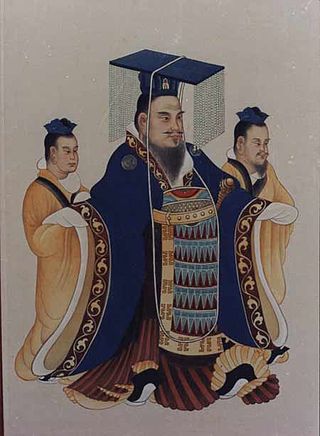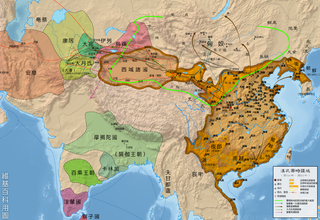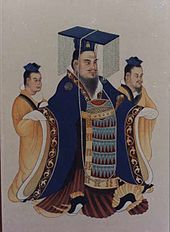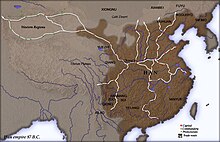This article concerns the period 119 BC – 110 BC.
This article concerns the period 139 BC – 130 BC.
Year 135 BC was a year of the pre-Julian Roman calendar. At the time it was known as the Year of the Consulship of Flaccus and Piso and the Sixth Year of Jianyuan. The denomination 135 BC for this year has been used since the early medieval period, when the Anno Domini calendar era became the prevalent method in Europe for naming years.

Emperor Wu of Han, born Liu Che and courtesy name Tong, was the seventh emperor of the Han dynasty from 141 to 87 BC. His reign lasted 54 years – a record not broken until the reign of the Kangxi Emperor more than 1,800 years later – and remains the record for ethnic Han emperors. His reign resulted in a vast expansion of geopolitical influence for the Chinese civilization, and the development of a strong centralized state via governmental policies, economical reorganization and promotion of a hybrid Legalist–Confucian doctrine. In the field of historical social and cultural studies, Emperor Wu is known for his religious innovations and patronage of the poetic and musical arts, including development of the Imperial Music Bureau into a prestigious entity. It was also during his reign that cultural contact with western Eurasia was greatly increased, directly and indirectly.

The Baiyue, Hundred Yue, or simply Yue, were various ethnic groups who inhabited the regions of southern China and northern Vietnam during the 1st millennium BC and 1st millennium AD. They were known for their short hair, body tattoos, fine swords, and naval prowess.

Zhao Tuo, rendered as Triệu Đà in Vietnamese, was a Qin dynasty Chinese general and first emperor of Nanyue. He participated in the conquest of the Baiyue peoples of Guangdong, Guangxi and Northern Vietnam. After the fall of the Qin, he established the independent kingdom of Nanyue with its capital in Panyu in 204 BCE. Some traditional Vietnamese history scholars considered him the founder of the Triệu dynasty while some contemporary historians contest that he was a foreign invader.

Nanyue, was an ancient kingdom founded in 204 BC by the Chinese general Zhao Tuo, whose family continued to rule until 111 BC. Nanyue's geographical expanse covered the modern Chinese subdivisions of Guangdong, Guangxi, Hainan, Hong Kong, Macau, southern Fujian and central to northern Vietnam. Zhao Tuo, then Commander of Nanhai Commandery of the Qin dynasty, established Nanyue in 204 BC after the collapse of the Qin dynasty. At first, it consisted of the commanderies of Nanhai, Guilin, and Xiang.

Zhao Mo was the second ruler of Nanyue. He succeeded his grandfather Zhao Tuo in 137 BC and reigned until his death in 124 BC.

The Triệu dynasty or Zhao dynasty ruled the kingdom of Nanyue, which consisted of parts of southern China as well as northern Vietnam. Its capital was Panyu, in modern Guangzhou. The founder of the dynasty, Zhao Tuo, was a Chinese general from Hebei and originally served as a military governor under the Qin dynasty. He asserted the state's independence in 207 BC as the Qin dynasty was collapsing. The ruling elite included both native Yue and immigrant Han peoples. Zhao Tuo conquered the Vietnamese state of Âu Lạc and led a coalition of Yuè states in a war against the Han dynasty, which had been expanding southward. Subsequent rulers were less successful in asserting their independence and the Han dynasty finally conquered the kingdom in 111 BC.

The First Era of Northern Domination refers to the period of Vietnamese history during which present-day northern Vietnam was under the rule of the Han dynasty and the Xin dynasty as Jiaozhi province and Jiaozhou province. It is considered the first of four periods of Chinese rule over Vietnam, and the first of the three in which were almost continuous and was referred to as Bắc thuộc.

Dian was an ancient kingdom established by the Dian people, a non-Han metalworking civilization that inhabited around the Dian Lake plateau of central northern Yunnan, China from the late Spring and Autumn period until the Eastern Han dynasty. The Dian buried their dead in vertical pit graves. The Dian language was likely one of the Tibeto-Burman languages. The Han Empire's annexation of the Dian kingdom in 109 BCE eventually led to the establishment of the Yizhou commandery. Dian culture started from at least the 8th century BCE, until it fell under the control of the Han dynasty in 109 BCE.

Minyue was an ancient kingdom in what is now the Fujian province in southern China. It was a contemporary of the Han dynasty, and was later annexed by the Han empire as the dynasty expanded southward. The kingdom existed approximately from 306 BC to 110 BC.

As trade was an important source of wealth for the Baiyue peoples of coastal southern China, the region south of the Yangtze attracted the attention of Emperor Qin Shi Huang, and he undertook a series of military campaigns to conquer it. Lured by its temperate climate, fertile fields, maritime trade routes, relative security from warring factions to the west and northwest, and access to luxury tropical products from Southeast Asia, the emperor sent armies to conquer the Yue kingdoms in 221 BC. Military expeditions against the region were dispatched between 221 and 214 BC. It would take five successive military excursions before the Qin finally defeated the Yue in 214 BC.
Zhao Yingqi was the son of Zhao Mo and the third ruler of the kingdom of Nanyue. His rule began in 122 BC and ended with his death in 115 BC.

The Han conquest of Nanyue was a military conflict between the Han Empire and the Nanyue kingdom in modern Guangdong, Guangxi, and Northern Vietnam. During the reign of Emperor Wu, Imperial Han military forces formally launched a punitive campaign against Nanyue and successfully conquered it in 111 BC.

The Han campaigns against Minyue were a series of three Han military campaigns dispatched against the Minyue state. The first campaign was in response to Minyue's invasion of Eastern Ou in 138 BC. In 135 BC, a second campaign was sent to intervene in a war between Minyue and Nanyue. After the campaign, Minyue was partitioned into Minyue, ruled by a Han proxy king named Zou Yushan, and Dongyue. During the concluding months of 111 BC, after the unsuccessful uprising led by Zou Yushan in thwarting General Yang Pu's conspiratorial intentions to undermine him, the aspiration for autonomous rule in Dongyue gradually waned. The rebellion instigated by Zou was suppressed, prompting the Han dynasty's complete annexation of Dongyue into its dominion and the conquest of the residual territories that constituted the former Minyue, effectively consolidating the permanent integration of both domains into the Han empire indefinitely.

The Han conquest of Dian was a series of military campaigns and expeditions by the Western Han dynasty recorded in contemporary textual sources against the Dian Kingdom in modern-day Yunnan. Dian was placed under Western Han rule in 109 BC, after Emperor Wu of Han dispatched an army against the kingdom as the empire expanded southward.
Kuaiji Commandery, formerly romanized as K'uai-chi Commandery, was a former commandery of China in the area of Hangzhou Bay. When first established, its capital was at Wu, which became known as "Kuaiji" from this role. The initial territory ran from the south bank of the Yangtze through most of modern Zhejiang to an indeterminate border among the free people of Minyue. Wu and Wuxing commanderies were later formed between the Yangtze and the north shore of Hangzhou Bay; the administration of the remainder of Kuaiji Commandery was then removed to the site of the former Yue capital in modern Shaoxing's Yuecheng District, which also became known as Kuaiji from this role. By the Tang, Hangzhou was also separated and Kuaiji ran from a little north of the Zhe River in the west to Ningbo in the east.

Dong'ou also known as Ouyue, was an ancient kingdom in modern Wenzhou and Taizhou, Zhejiang Province, China. The realm of Dong'ou was given to Zou Yao by Emperor Gaozu of Han in 192 BC. During the Han campaigns against Minyue in 138 BC, the king of Dong'ou no longer wished to live in his realm after the incident, having submitted himself in an prostrating gesture, which was indicative of his final acquiescence as a mere supplicant to have him and his people's eventual fates to be absorbed into the Han empire. After Zou Yushan's unsuccessful uprising against General Yang Pu's conspiratorial intentions to subvert him, which aimed to protect Dongyue's independence, the aspiration for autonomous control over Dongyue gradually dissipated during the final months of 111 BC. Zou's uprising was suppressed, prompting the Han dynasty to eventually incorporate Dongyue and the remaining territories of the former Minyue, thereby permanently securing the complete annexation and assimilation of both domains into the Han empire.

The Changsha Kingdom was a kingdom within the Han Empire of China, located in present-day Hunan and some surrounding areas. The kingdom was founded when Emperor Gaozu granted the territory to his follower Wu Rui in 203 or 202 BC, around the same time as the establishment of the Han dynasty. Wu Rui and his descendants held the kingdom for five generations until Wu Zhu died without an heir in 157 BC. In 155 BC, the kingdom was reestablished for a member of the imperial family. However, the creation of this second kingdom coincided with the Rebellion of the Seven States and the subsequent reforms under Emperor Jing, and Changsha under the imperial family saw its autonomy greatly diminished. The kingdom was dissolved during Wang Mang's usurpation, briefly restored after the founding of the Eastern Han, and finally abolished in AD 33 and converted to a commandery under the imperial government.






















